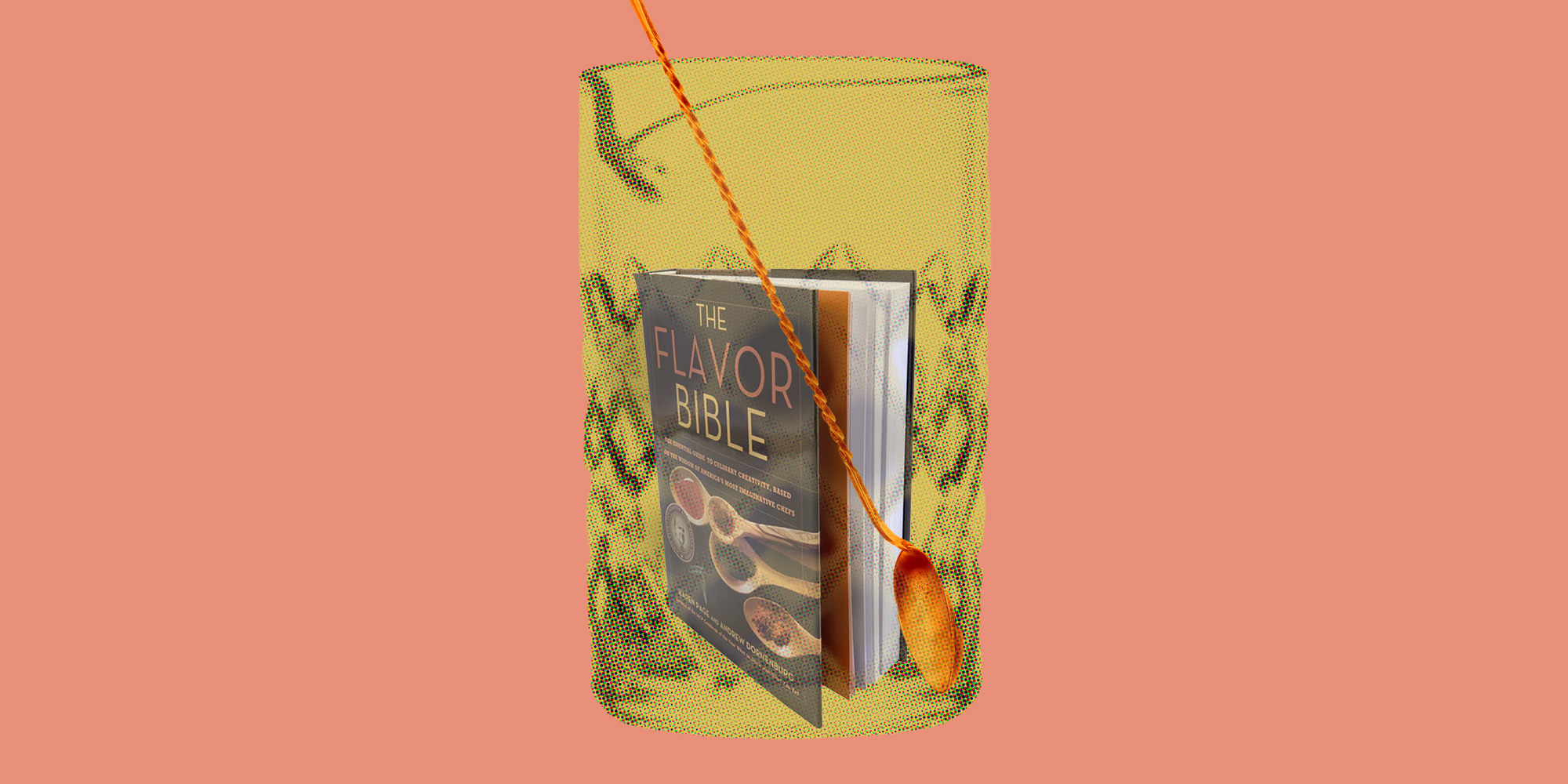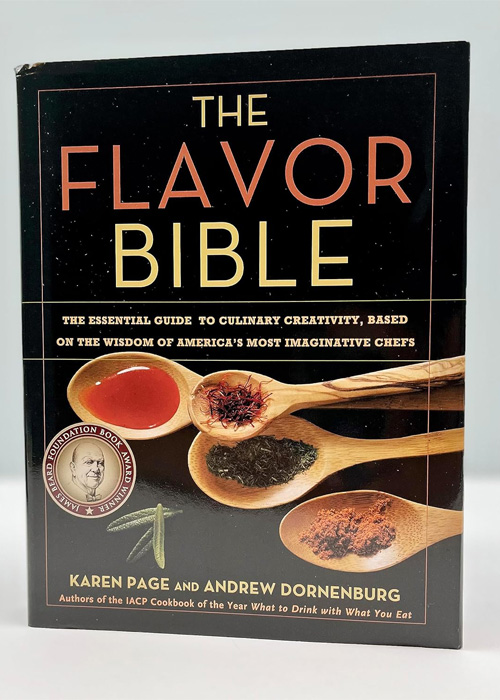


At a recent symposium on sustainability, the moderator queried a panel of bartenders about their favorite bartending books. I’ve heard the question posed many times through the years, but one bartender’s unequivocal response that day reminded me how often the answer is the same. Shockingly, the book isn’t about cocktails or bartending techniques at all.
Originally published in 2008, Karen Page and Andrew Dornenburg’s book “The Flavor Bible: The Essential Guide To Culinary Creativity, Based on the Wisdom of America’s Most Imaginative Chefs” has quietly reached cult status within the bar industry. The 392-page tome, which hit shelves during the embryonic stages of the cocktail revolution, was originally designed to encourage chefs and home cooks to develop better instincts by deepening their understanding of flavor combinations.
“Bar books are more about telling you how to be a bartender, the craft and ethic of bartending,” says Leila Miller, the bartender at the symposium who cited the book as her favorite. “But with ‘The Flavor Bible,’ you’re constantly using it for different things.”
Through the years, craft bartenders like Miller have embraced the way the book trains them to approach cocktail design with a chef’s mindset. In the absence of a definitive resource for how to harness the power of flavor in cocktails, Page and Dornenburg’s book has become canon for modern mixologists.
According to the book’s preface, “The Flavor Bible” is “a comprehensive, easy-to-use single-volume reference of more than 600 alphabetical entries listing modern-day compatible flavors, chronicling new flavor synergies in the new millennium.” The bulk of the book is a flavor matrix, itemized by individual ingredients listed from A to Z. Each ingredient is accompanied by suggested flavor pairings with a ranking system that denotes the different degrees of compatibility for each suggested match. It also weaves in commentary and anecdotes from notable chefs like José Andrés and Eric Ripert with insights on how they approach flavor and what defines great cooking.

“The Flavor Bible” is the rare cookbook that contains no recipes. Instead, it reads more like a treatise on music theory that regards flavor affinities like harmonious chords, encouraging readers to use suggested pairings, like rhubarb with ginger and spearmint or tamarind with Thai chile and mustard, as launching points for their own culinary creations. Early on, the authors were surprised to find that many of the principles espoused in the book that were meant to apply to the kitchen could also apply to the bar. But over time, they began to understand how the book was helping bartenders approach their craft more intuitively.
“Bartending is like cooking without the application of heat,” says Dornenburg. “Things like grating nutmeg over a cocktail, adding a dash of bitters, or flaming a citrus peel are like seasoning. All the different kinds of garnishes are just ways of adding more flavors.”
As restaurant bars and kitchens became more symbiotic, bartenders gravitated to the book for the same reasons chefs did, to explore unique flavor combinations by looking up ingredients to find their kindred spirits. “It’s more like a flavor atlas or a flavor thesaurus,” says Toby Maloney, a partner and the head mixologist at The Violet Hour in Chicago. “If I know where I’m starting, I can look at a couple pages and see how to get where I’m going.”
When the book was first published in 2008, craft bartenders were already beginning to look beyond the lexicon of classic cocktail recipes. Contemporary bartending manuals at the time were primarily technique-based, like Dale DeGroff’s “The Craft of the Cocktail” (2002) and Gary Regan’s “The Joy of Mixology” (2003), and they focused more on cocktail history and mastering the classics like the Martini and Old Fashioned. “The Flavor Bible” became a seminal text for a new class of curious bartenders who wanted to test the limits of what bartending could be.
Even before “The Flavor Bible” was published, Page and Dornenburg’s earlier work was already influencing the pioneering mixologists who helped jumpstart the cocktail revolution. As a young bartender, Audrey Saunders discovered their 1996 book “Culinary Artistry,” which codified many of the concepts she’d learned studying French cooking technique in culinary school. “In those days there weren’t any cocktail books that had a culinary focus, and I often found myself drawn to the cookbook sections of bookstores,” says Saunders, who co-owned the iconic New York City bar Pegu Club before it closed during the pandemic. “I bought ‘Culinary Artistry’ almost immediately after it came out.”
“I wasn’t thinking about flavor the same way that all those bartenders were thinking about flavor. I wasn’t creating any cocktails that were interesting, so I decided I needed to understand how to cook.”
Saunders was eager to apply Page and Dornenburg’s principles in a way that allowed bartenders to embrace the culinary ethos traditionally reserved for chefs. “Because of the inspiration and insights that it provided me, I began to closely follow Karen and Andrew’s work and picked up all of their subsequent books,” Saunders says. She stresses that Page and Dornenburg’s anthology, which comprises 11 books including other titles like “What to Drink with What You Eat” and “Kitchen Creativity,” should be regarded as a series, not just one individual volume.
Maloney recalls relying on the book regularly to overcome the drinks equivalent of writer’s block when his iconic Chicago bar was still in its infancy. “I’m sure I looked at it for every cocktail menu I did at The Violet Hour in those early years, when I was traveling a lot and had to create menus in my head without being able to do taste tests,” he says.
Troy Sidle joined Maloney at The Violet Hour in 2009 and credits “The Flavor Bible” for signaling a shift in his attitudes toward mixology. “I wasn’t thinking about flavor the same way that all those bartenders were thinking about flavor,” Sidle says. “I wasn’t creating any cocktails that were interesting, so I decided I needed to understand how to cook.” After Maloney shared “The Flavor Bible” with Sidle, it became one of his most trusted resources for cocktail recipe development. “I still use the book to this day when I’m stuck and need that one unexpected twist in a cocktail,” Maloney says.
The gospel of “The Flavor Bible” inside the bar industry continues to spread primarily through word of mouth. “My mentor and friend Will Patton gave me his copy,” says Sara Chaudhuri, the lead bartender of Bresca in Washington, D.C., and a finalist in VinePair’s Next Wave Awards. “It’s very well worn, the spine is about to fall off, and there are pages folded with little Post-it notes throughout.” Chaudhuri credits the book for inspiring some of her favorite flavor combinations, like a highball she recently developed with Japanese whisky, Concord grapes, and fresh ginger. Though she references the book less frequently as part of her daily bartending practice, it still holds a special place in her personal library. “Having had it handed down as an inheritance makes it even more valuable to me,” she says.
“I think perhaps the reason ‘The Flavor Bible’ has remained relevant for so long is because it provides a rare tool that encourages a bartender’s own creativity,” says author Page, “rather than simply providing specific recipes that are known to work through duplication, which helps to make their work more enjoyable, fresh, and meaningful.” Page and Dornenburg continue to marvel at the book’s longevity, estimating that it’s sold well over half a million copies over its lifetime.
“Bartenders are so done with the crazy field of random-ass bar books,” says Miller, who runs the beverage programs at Vicia and Taqueria Morita in St. Louis. “They get redundant to a point.” A worn copy of “The Flavor Bible” sits on a shelf adjacent to the bar at Vicia nestled alongside copies of foundational texts like Dave Arnold’s “Liquid Intelligence” and David Wondrich’s “Imbibe!”
“I love all of these books,” Miller says. “But ‘The Flavor Bible’ is the only one that makes me think outside the box.”
The article The Cookbook That Became Every Bartender’s Trusted Companion appeared first on VinePair.